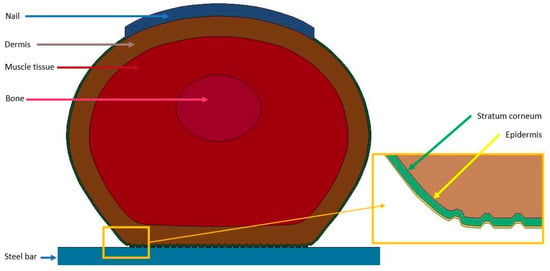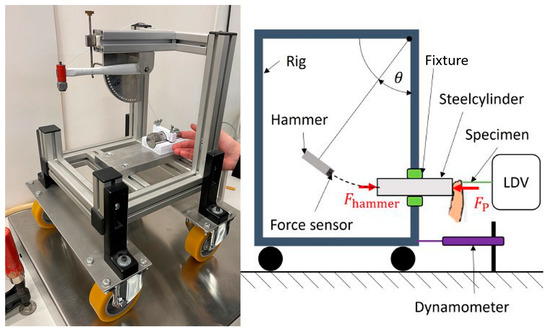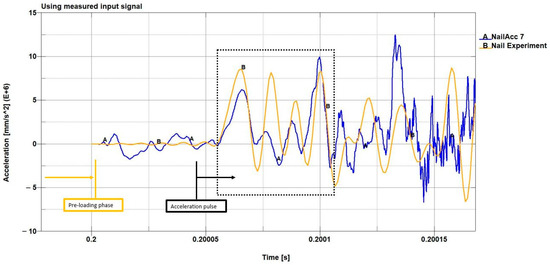Abstract
High-frequency shock-type vibrations (HFVs) from, e.g., impact wrenches with a frequency content mainly above 1250 Hz have long been suspected to cause a significant number of vibration injuries, HAVS. These vibrations are unregulated in the current standard for risk estimation, ISO 5349-1; thereby, the risk of injury is suspected to be underestimated. The objective of this study was to investigate the effects on finger tissue subjected to HFVs similar to those from impact wrenches by using a 2D finite element model of a fingertip. The model was validated through experiments. Using the input acceleration from the experiments, the model predicted high pressure variation and particular negative pressures at levels close to 0.1 MPa (1 Bar) or more, which are levels where cavitation in liquid can occur, with a detrimental effect on biological systems.
1. Introduction
High-frequency shock-type vibrations (HFVs) with an energy content mainly above 1250 Hz are likely to cause a significant number of vibration injuries [1], but there is an inadequate understanding of the injury mechanisms. There is also no standard assessing the risk associated with these vibrations. The current standard, ISO 5349-1, that all regulations and legislations are based on only covers the octave bands from 8 Hz to 1000 Hz. The objective of this study was to gain knowledge on the physical entities inside a finger at the local tissue level where injures are suspected to occur when subjected to HFVs, in order to develop mitigation measures. To enable detailed studies of the propagation of HFVs occurring in the use of, e.g., an impact wrench, a 2D finite element model of a fingertip was developed. The geometries of the constituents are schematic to resemble the fingertip morphology rather than being an exact representation of an existing finger.
2. Materials and Methods
2.1. Model
The model of a schematic fingertip is shown in Figure 1. This model includes the major components of the human skin, i.e., stratum corneum, epidermis, dermis and subcutaneous tissue. The geometric properties of the different skin layers and the overall dimensions of the finger were derived from findings published in [2,3]. Special attention is paid to the contour of the fingerprint where load introduction appears. The 3D contour was scanned with imaging confocal microscopy and parametrized. The dimensions were integrated into the simulation model. The model consists of 63,500 2D elements (plane strain) located in the global xy-plane. Element sizes range from 0.01 mm (the smallest) in the stratum corneum to 0.08 mm in the bone. A fully integrated 2D plane strain element formulation with four in-plane integration points was used throughout this work, counteracting any spurious deformations, i.e., hourglass modes. This continuum element enables the use of material models corresponding to 3D continuum elements.

Figure 1.
Two-dimensional fingertip model.
2.2. Material Data and Material Models
The difficulties in determining the material parameters for living tissue to be used in numerical modeling are notorious. Literature data on the mechanical properties of the skin layers (stratum corneum, epidermis, dermis and subcutaneous tissue) reveal differences in the order of magnitude, depending on the test setup, loading conditions, gender, age, location and environmental conditions [2,3,4,5,6]. Material data for the stratum corneum and epidermis stated in [2] were further refined through an experimental investigation of the finger and fingerprint distortion under compressive forces. These results were used to validate the finite element simulation model using an inverse optimization approach [7]. The material response of the skin layers is time- and history-dependent; therefore, a viscoelastic constitutive model, based on exponential stress relaxation functions, was used [8,9].
2.3. Experimental Data for the Modeling
The experimental setup is shown in Figure 2. It generates a vibration pulse with high repeatability and amplitude, similar to ordinary hand-held impact wrenches. From this experiment, the acceleration of the steel surface was extracted. After post-processing, this signal was used as the input for the FE model to avoid numerical disturbances. The response in the nail was measured up to 100 kHz using a laser Doppler vibrometer (LDV) that registered the resulting accelerations at the nail tip. The signal was sampled at 1 MHz.

Figure 2.
Photo of the experimental setup used and schematic of the experimental setup.
2.4. Numerical Aspects
The commercial software LS-Dyna was used for the finite element simulations. Two different numerical schemes were used, i.e., implicit and explicit time integration. In the experiments, a pre-load was applied; thus, a pre-load was required even in the numerical models. The static nature of this pre-loading made it more suitable to use implicit time integration for this phase. Once the pre-loading face was fulfilled, the switch between the numerical algorithms was carried out automatically, and the program entered the explicit time integration scheme. The high acceleration dynamics in the excitation required explicit time integration, where time stepping was continuously incremented, basing the time step on the smallest dimension of all the elements in the model.
3. Results
The measured response of the nail acceleration in the experiments was used to compare the experiment with the simulations using the model (Figure 3). The correlation for the first measured acceleration peaks, which are considered to be of utmost importance, was fairly good between the experiment and FE simulation, as can be seen in Figure 3. Then, the correspondence deteriorated, even though some peaks were later comparable.

Figure 3.
Measured acceleration on the nail surface (yellow) compared with the FE result (blue) from the corresponding point on the nail.
Pressure variation is considered vital for the consequences of shock-vibration-related tissue damage. Notably, negative pressures at levels close to 1 bar (equal to 0.1 MPa) or more were found in the stratum corneum and epidermis in these analyses (Figure 4).

Figure 4.
Pressure field in Mpa in the model immediately after the acceleration pulse hit the steel bar. N.B. Negative pressures are shown in green to blue colors.
4. Discussion
The first peak is of major importance, and there can be many reasons for the discrepancies between the experiment and simulation with respect to this; the material parameters will have an influence, and the values may show significant variation between individuals.
Numerical contact formulations can contribute to numerical noise. In fact, the switching from an implicit solution technique to a subsequent explicit analysis can cause oscillations that can be detected if the acceleration signal is applied with a latency time.
Another concern is that strain rates can be of significance when it comes to tissue damage. Currently, it is not known at what level of strain rate certain tissues are at risk. High strain rates might also suggest the use of more elaborate material models to study such effects accurately.
5. Conclusions
The 2D fingertip model can be pre-loaded and exposed to accelerations from experiments to yield the first-order correspondence with the experimentally measured output. Through this, it is assumed, but not proven, that the physical entities in the internal structures as a consequence of these mechanical loads correspond to the structures in a finger experienced in such an environment.
It would be invaluable to gain access to in situ measurements of the response in the fingertip to correlate the simulation results. Measurement of the pressure in the respective structural layers of a fingertip can provide results that can be used for the validation of the model. This can be achieved by measuring the pressure using, e.g., a catheter with a Fabry–Pérot etalon.
Data used in the model can be improved in various ways. The described uncertainties with respect to the material data and material models, as well as the vast variation in the human population, are one area of possible improvement.
The model itself can be improved in various ways, from elaborating the geometry or using a more morphologically correct configuration to utilizing a higher mesh resolution and more advanced numerical techniques. Pressures could be vital for the consequences of shock-vibration-related tissue damage. Negative pressures at levels close to 1 bar (equal to 0.1 MPa) or more were found in these analyses, which are levels where cavitation in liquid can occur, with a detrimental effect on biological systems. The results indicate the need for deeper knowledge of the physical processes at the tissue level in humans in order to prevent vibration injury.
Author Contributions
H.L. and S.L.G. conceived and planned the experiments. H.L. and S.L.G. carried out the experiments. P.O. planned and carried out the simulations. H.L. supervised the findings of this work. All authors have read and agreed to the published version of the manuscript.
Funding
This research was funded by DGUV Forschungsförderung, FP-415 (www.dguv.de).
Institutional Review Board Statement
The study was conducted in accordance with the Declaration of Helsinki, and approved by the Ethics Committee of Luebeck University (protocol code 20-099, April 2020).
Informed Consent Statement
Not applicable.
Data Availability Statement
Not applicable.
Conflicts of Interest
The funders had no role in the design of the study; in the collection, analyses or interpretation of data; in the writing of the manuscript; or in the decision to publish the results.
References
- Dandanell, R.; Engström, K. Vibration from riveting tools in the frequency range 6 Hz-10 MHz and Raynaud’s phenomenon. Scand. J. Work Environ. Health 1986, 12, 338–342. [Google Scholar] [CrossRef] [PubMed]
- Vodlac, T.; Vidrih, Z.; Sustaric, P.; Rodic, T.; Wessberg, J.; Peric, D. Computational assessment of spiking activity during surface exploration: From finite element analysis to firing-rate. In Haptics: Perception, Devices, Control and Applications; Springer: Berlin/Heidelberg, Germany, 2016. [Google Scholar]
- Geerlings, M. In Vitro Mechanical Characterization of Human Skin Layers: Stratum Corneum, Epidermis and Hypodermis; Technical University Eindhoven: Eindhoven, The Netherlands, 2006. [Google Scholar]
- Leyva-Mendivil, F.; Page, A.; Bressloff, N. A mechanistic insight into the mechanical role of the stratum corneum during stretching and compression of the skin. J. Mech. Behav. Biomed. Mater. 2015, 49, 197–219. [Google Scholar] [CrossRef] [PubMed]
- Pal, S. Design of Artificial Human Joints and Organs; Springer: New York, NY, USA, 2014. [Google Scholar]
- Goss, S.A.; Johnston, R.L.; Dunn, F. Comprehensive Compilation of Empirical Ultrasonic Properties of Mammalian Tissues; Bioacoustics Research Laboratory, University of Illinois: Urbana-Champaign, IL, USA, 1978. [Google Scholar]
- Lindell, H.; Grétarsson, S.L.; Machens, M. High Frequency Shock Vibrations and implications of ISO 5349—Measurement of vibration, Simulating Pressure Propagation, Risk Assessment and Preventive Measures. In Proceedings of the Report from Workshop on Single Shocks at 13th International Conference on Hand-Arm Vibration, Bejing, China, 16 October 2015. [Google Scholar]
- Herrman, L.; Peterson, F. A numerical procedure for viscoelastic stress analysis. In Proceedings of the 7th Meeting of ICRPG Mechanical Behavior Working Group, Orlando, FL, USA, 14–15 November 1968. [Google Scholar]
- Krave, U. Modelling of Diffuse Brain Injuries: Combining Methods to Study Possible Links between Transient Intracranial Pressure and Injury; Doctoral thesis of Engineering; Chalmers University of Technology: Gothenburg, Sweden, 2010. [Google Scholar]
Disclaimer/Publisher’s Note: The statements, opinions and data contained in all publications are solely those of the individual author(s) and contributor(s) and not of MDPI and/or the editor(s). MDPI and/or the editor(s) disclaim responsibility for any injury to people or property resulting from any ideas, methods, instructions or products referred to in the content. |
© 2023 by the authors. Licensee MDPI, Basel, Switzerland. This article is an open access article distributed under the terms and conditions of the Creative Commons Attribution (CC BY) license (https://creativecommons.org/licenses/by/4.0/).